N-desmethyl-doxepin and methods of using the same to treat sleep disorders
a technology of n-desmethyl doxepin and sleep disorders, which is applied in the field of desmethyl doxepin, can solve the problems of short-term insomnia and other problems, and achieve the effect of improving sleep quality and improving sleep quality
- Summary
- Abstract
- Description
- Claims
- Application Information
AI Technical Summary
Benefits of technology
Problems solved by technology
Method used
Image
Examples
example 1
[0061]Desmethyldoxepin is prepared according to the following method. Anhydrous 3-methylaminopropyltriphenylphosphonium bromide hydrobromide (1530 g) prepared as in U.S. Pat. No. 3,509,175, is suspended in 4.5 L dry tetrahydrofuran and 6.0 moles of butyl lithium in heptane is added during 1 hour. After an additional 30 minutes, 483 g of 6,11-dihydrodibenz(b,e)oxepin-11-one, is added to the deep red solution and the reaction is maintained at reflux for 10 hours. Water, 500 mL, is added at room temperature and the solvent is removed in vacuo. The crude residue is treated with 10% hydrochloric acid until acidic (pH 2) and then 1.5 L benzene is added. After stirring, the mixture separates into three phases (an insoluble hydrochloride salt product phase, an aqueous phase and an organic phase). The benzene layer is removed by decantation and the remaining mixture is rendered basic with 10% sodium hydroxide solution and is extracted with 3×1500 mL portions of benzene. The benzene extracts ...
example 2
[0062](E)-Desmethyldoxepin is prepared from doxepin hydrochloride as follows. Doxepin hydrochloride (E / Z=85 / 15) (55.0 g, 0.174 mol) is dissolved in 600 mL H2O, made basic with 6M NaOH, and extracted with CHCl3 (3×600 mL). The CHCl3 extracts are combined, dried over Na2SO4, and solvent removed in vacuo. The resulting oil is dissolved in 250 mL EtOH, then 21.15 g (0.182 mol) of maleic acid dissolved in 100 mL EtOH is added slowly, with stirring, followed by an additional 350 mL EtOH. The resulting cloudy solution is refluxed until it becomes clear, then allowed to stand overnight at room temperature; the resulting crystals are isolated by vacuum filtration. Additional recrystallization from EtOH yields a white crystalline product ((E)-Doxepin maleate) with an E / Z ratio of 98 / 2. (E)-Doxepin maleate (2.50 g, 6.32 mmol) is then partially dissolved in 60 mL H2O, made basic with 6M NaOH, and extracted with CHCl3 (3×60 mL). The CHCl3 extracts are combined, washed with 60 mL brine, dried ove...
example 3
[0063](Z)-Desmethyldoxepin is prepared from doxepin hydrochloride as follows. Doxepin hydrochloride (E / Z=85 / 15) (100 g, 0.317 mol) is dissolved in 800 mL H2O, made basic with 6M NaOH, and extracted with CHCl3 (3×800 mL). The CHCl3 extracts are combined, dried over Na2SO4, and solvent removed in vacuo. The resulting oil is dissolved in 700 mL EtOH, then 36.7 g (0.317 mol) of maleic acid dissolved in 600 mL EtOH is added slowly, with stirring. The resulting cloudy solution is refluxed until clear, then allowed to stand overnight at room temperature. Crystals are isolated by vacuum filtration and the mother liquor saved. Crystals are recrystallized two additional times as above, and the three mother liquors saved and combined and solvent removed in vacuo. Recrystallization of mother liquor material from refluxing EtOH eventually affords 24 g of a mother liquor product which is 65% Z isomer in composition. Recrystallization of this material from 450 mL EtOH gives crystals (9.1 g) which ...
PUM
| Property | Measurement | Unit |
|---|---|---|
| pH | aaaaa | aaaaa |
| affinity | aaaaa | aaaaa |
| mental disorder | aaaaa | aaaaa |
Abstract
Description
Claims
Application Information
 Login to View More
Login to View More - R&D
- Intellectual Property
- Life Sciences
- Materials
- Tech Scout
- Unparalleled Data Quality
- Higher Quality Content
- 60% Fewer Hallucinations
Browse by: Latest US Patents, China's latest patents, Technical Efficacy Thesaurus, Application Domain, Technology Topic, Popular Technical Reports.
© 2025 PatSnap. All rights reserved.Legal|Privacy policy|Modern Slavery Act Transparency Statement|Sitemap|About US| Contact US: help@patsnap.com

